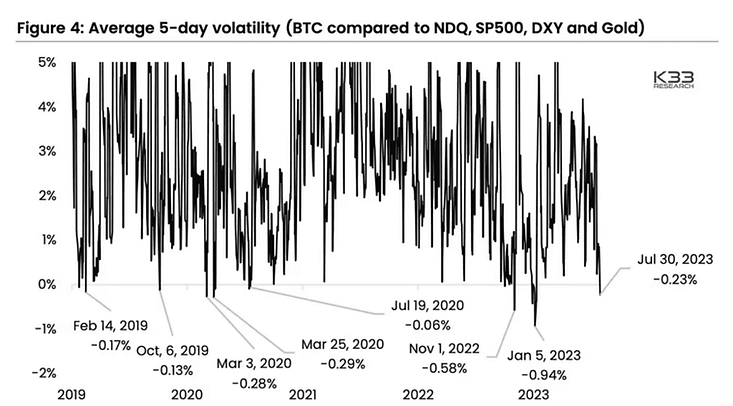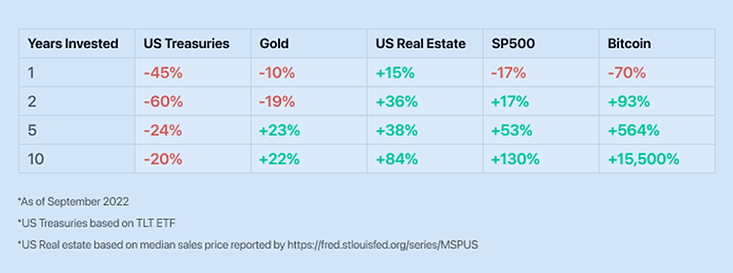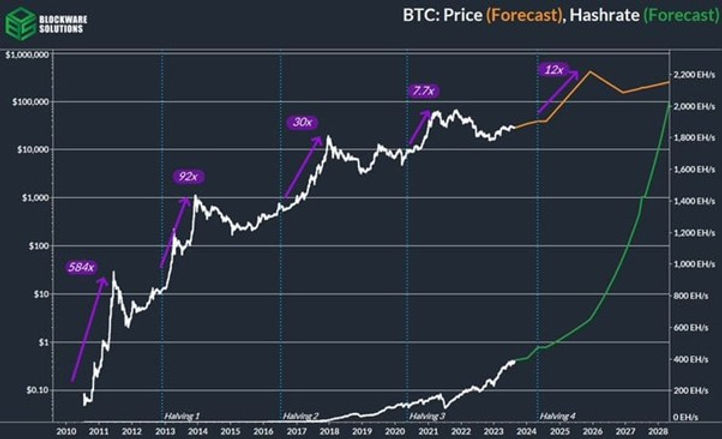Crypto volatility, big banks and bullish booms

We love crypto, but isn’t it really volatile?
If you have spoken to anyone about crypto, around 90% of people will say the reason they do not invest is because “crypto is too volatile”. Yes, in the fifteen years since it was birthed, Bitcoin has had several drops of 80% in value, but has also had massive swings to the upside as well.
Many pro-crypto financial advisers have stated that adding crypto to a portfolio of stocks and bonds actually results in less volatility, because crypto has a low correlation to other assets.
We finally have scientific proof. Analysis from K33 Research shows that the volatility of Bitcoin is lower than gold, lower than the S&P500 and lower than the NASDAQ 100.
For those who say “crypto is too volatile”, you can now tell them that it is actually less volatile than most stocks and gold bullion. Yeah, science!

Crypto: the longer you do it, the better it gets
Volatility is the chance of the unexpected happening. When investing into good quality assets for the longer-term, volatility is reduced. Imagine buying stock in your favourite airline on Monday, and a plane crashes on Tuesday. Your stock will likely drop in price in the short-term, but if you hold, prices should eventually recover.
We all know that crypto can drop by 50-90% in a bad year. We also know that a good year can see gains of over 1000%. The longer you hold your good assets, the more the peaks and troughs balance out.
The box below shows that investing in so-called “rock solid” assets like US Government Bonds or Gold, could have seen you lose 10% up to 45% in a bad year. The results for one bad year in crypto were even worse at minus 70%. But if you had held on for five years, Bitcoin outperformed gold, bonds, stocks and real estate by more than ten times. The ten-year performance is more than one hundred times as good. Stick with it, puppies.

News from Cryptnation: Banks versus Crypto
The ongoing battle between banks and cryptocurrencies, stemming from Bitcoin’s creation as a response to the 2008 banking crisis, has led to a complex evolution of blockchain technology and digital assets.
Banks are increasingly realising the potential threat and exploring ways to incorporate the blockchain’s underlying distributed ledger technology (DLT). Major financial institutions like Goldman Sachs, HSBC, JP Morgan, and Société Générale are creating their digital asset platforms and collaborating with blockchain platforms. Governments and central banks globally are also partnering with cryptocurrency companies and DLT platforms.
A notable trend is the exploration of Central Bank Digital Currencies (CBDCs) driven by the shift to cashless transactions and initiatives like Facebook’s failed Libra and Paypal’s successful PYUSD. Today, 114 central banks are probing CBDCs, a massive leap from just 35 in 2020. These countries constitute 58% of the global nations and over 95% of the global GDP. While CBDCs offer benefits, they also raise debates about centralisation, government oversight and diverging from Bitcoin’s core principles.
Tokenisation is gaining interest for real-time settlement and market share expansion through stablecoin-based checking accounts. Tokenised repos, debt issuances, and bond markets are becoming popular due to efficiency gains. Notably, financial institutions like Société Générale and the European Investment Bank have demonstrated the potential of tokenised bonds.
By using tokenised technology, Citibank India were able to see a 90% reduction in processing time, going from 5-10 days down to 3 hours on average.
Financial institutions have been secretly investing billions into crypto, including Morgan Stanley ($1.1bn), Goldman Sachs ($700m), BNY Melon ($700m), Commonwealth Bank of Australia ($420m), and Citigroup ($215m).
Major players such as BlackRock, HSBC, and Fidelity have filed for Bitcoin exchange-traded funds (ETFs), which will make it as easy for investors to get into crypto as they can into stocks. (More below)
Government entities and central banks worldwide are also capitalizing on cryptocurrency companies and distributed ledger platforms. Some fitting examples are the Bank of Canada partnering with R3, the Monetary Authority of Singapore joining forces with ConsenSys, the Norges Bank aligning with Nahmii, the Royal Monetary Authority of Bhutan partnering with Ripple, the Bank of Jamaica partnering with eCurrency Mint, and the Central Bank of Nigeria partnering with Bitt, among others.
It is evident that the banks and traditional financial institutions are highly interested in crypto. They are increasingly embracing DLT, blockchain, and tokenization for efficiency, cost reduction, and capital reallocation. The adoption of blockchain technology seems inevitable across the world.

When crypto turns savage
“Not your keys, not your crypto” is the old saying. It is wise to Do Your Own Research (DYOR) and hold your own keys. It is less wise to trust others to do it for you. Some people found out the hard way that crypto can be hazardous, and others may have taken the law into their own hands: murdering those who took their funds. Scammers be warned!!

How high can crypto go in 2024?
Many naysayers will give BTC targets of $0, but they have been saying that every year for fifteen years, so we are starting to think it is a case of Sour Grapes (also known as, “I missed out, I refuse to change my mind, so I am spreading my own misery to others… because misery loves what? Company”)
Meanwhile, proper analysts who have actual degrees and research software are predicting massive new highs that , quite frankly, sound a little unbelievable to us.
Could Bitcoin hit $400 000 and other cryptos increase by ten or twelve times over?

We are cautiously optimistic of a tenfold increase, but, nobody in our office predicted the thirty-fold increase of 2017-2018, or the ninety-fold increase of 2013-2014, so what the bleep do we know?
Check out the chart above from the pointy-headed boffins, and click here if you want a more detailed analysis.

The proof is in the putting…
We love a hackneyed cliché as much as anyone; even more if it is hacked up. We always love hearing someone say “it’s a doggy-dog world” or referring to someone else as a “social piranha”. Some delicious hacked-up cliches are, “you can’t have your cake and eat it” and “the proof is in the pudding”.
Both statements are wrong on analysis, as you can definitely have a cake and then eat it, but “you can’t eat your cake and have it”. There is no proof in the pudding, as any pudding can look great, but “the proof of the pudding is in the eating”; that’s where you find out if the beautiful is also delicious.
We know that many traditional banks and financial institutions have been slamming crypto for years in the press, even going so far as to close the bank accounts of crypto businesses or preventing transfers to and from crypto platforms.
But as shown above, many major institutions have been putting their money into crypto partnerships, adopting blockchain technology and investing into smart contracts. If your bank tells you that you can not or should not invest into crypto, but then the bankers themselves go and invest into it, perhaps ignore their advice and just watch where they are putting their money. The proof may well be in the putting.

We fought the law, and the law… lost?
In recent weeks we have seen major institutions putting billions of dollars into crypto assets, and even facing down the regulators in a court of law.
The Securities & Exchange Commission (SEC) in the USA has previously labelled almost every crypto as “an unregistered security”, causing not only flash crashes, but even the delisting of many crypto assets.
The SEC faced off against Ripple Lab’s XRP token in court, but after a price drop and XRP being removed from some crypto exchanges, the underdog won. The judge found that XRP was not an unregistered security when sold to individual investors. That was a big win for crypto and an embarrassment for the SEC.
The second legal case was pure hypocrisy: the SEC had previously allowed crypto exchange CoinBase to list on the stock exchange, but then accused them of selling unregistered securities. In court filings, Coinbase argued that “the SEC has violated due process, abused its discretion, and abandoned its own earlier interpretations of the securities laws”. Coinbase stock plummeted from over $300 to around $33 during the trial, and has now bounced back up over $100. If you had the courage to “buy the dip”, good for you. We picked up COIN for a bargain at around $50 and will continue to hold.
The third case involves institutional filing for a Bitcoin exchange-traded fund (ETF). The judge stated that “…the denial of Grayscale’s (BTC ETF) proposal was arbitrary and capricious because the Commission failed to explain its different treatment of similar products.”
We assume you have not been called arbitrary and capricious by a high court judge lately. In that case, you may be familiar with similar or more common insults such as someone saying you are “erratic”, “unpredictable”, “a whackjob” or “you just make up crap as you go along”.
This third embarrassment for the SEC (and arguably the most quotable) may be the nail in the coffin for the regulator who is not regulating regularly or reliably.
The Grayscale Bitcoin Trust (GBTC) price rose 9% in the last few days after their victory, with Bitcoin (BTC) up 5% and Coinbase (COIN) prices up around 13%.
The easy answer as to why COIN and GBTC rose more than Bitcoin is because anyone with a pulse and a free broking account can buy listed stocks such as GBTC and COIN. Buying crypto is slightly harder than buying stocks (for the moment), so the Bitcoin price has not increased as much as the stocks. Institutional investors such as family offices, trusts, pension funds or corporations are easily able to invest in stocks or ETFs, but may not yet have cryptocurrency as an approved asset.
When the thrice-embarrassed SEC backs down, we expect crypto ETF approval for Grayscale, Blackrock, Fidelity and ARK, if not several others as well.
Once that happens, there will likely be floods of institutional cash heading for the approved crypto products. The newly-approved ETFs will then have to purchase cryptocurrency on the open market, driving prices up.

When I say “crypto”, you say “how high?
The Boston office puppies are forecasting a “perfect crypto storm” as the approval of institutional crypto funds in the USA may cross over the upcoming Bitcoin halving event due in the next six months.
Previous Bitcoin halvings have seen gains of 700%, 3000%, 9000% and 58 000%, without the ingress of institutional funds, so where we end up is anyone’s guess. Legendary tech investor and CEO of ARK Investments, Cathie Wood has recently gone on record with two BTC price predictions: one for US$600 000 and another for US$1.5 million.
There has been no comment on new all-time highs for altcoins, but we can guess that history may echo once more. Perhaps it may be time to wake up your sleeping friends, show them a couple of the charts in this article, and get them to climb on board the crypto train while they still can.
STOP PRESS
Elon Musk has announced that X, the platform formerly known as Twitter, has obtained a license to enable crypto payments. You may be able to not only pay for your blue Twitter tick with crypto, but you may also be able to send funds to friends and family using their twitter handle, rather than a long complicated crypto wallet address. Stay tuned!
The blockchain has no secrets: a large buyer has accumulated over $3 billion worth of Bitcoin in the last 90 days. The buyer had secretly purchased from miners and discreet over-the-counter (OTC) transactions, avoiding exchanges so nobody could see or move the price up; however, all activity is recorded on the blockchain. Suspicions abounded that it could be Blackrock or Grayscale, but it was found to be stock exchange RobinHood. Will they also apply for a BTC ETF? Time will tell.

How did we do this month?
After a long crypto winter, it is nice to see the green shoots coming out for springtime. The Bostoncoin diversified fund had some nice gains on its more conservative balanced portfolio
· Ethereum up 116%
· Bitcoin up 146%
· SUI up 157%
· XRP up 170%
If you have not yet had a chance to see the live portfolio tool on the Boston website, have a play around with it! You can choose bubble view with interactive charts, bar chart, pie chart and more. This interactive chart is updated daily as we buy or sell, so you don’t have to wait until the end of the month to see how your investment is performing. Live BOS token pricing is also coming soon.
The Bostoncoin fund is up 28.5% year to date (YTD), 45% over three years, 233% over four years, and 170% over five years. It has been a wild ride so far. We expect more volatility in the next 12-18 months, with a few dips and massive upside from the institutional fund tsunami.
If your friends are still on the sidelines, show them this newsletter as proof that crypto has less volatility than gold, stocks and bonds, so maybe it has a place in their portfolio.
According to the same sources, crypto has outperformed every other asset class by a long margin… provided that you hang in there for the longer-term. Develop what the kids call “diamond hands” to hold on strongly through the dips, and stick with the diamond dogs and the puppy pack at BostonTrading.co
As at Aug 31 2023
- BOS NAV AUD 56.9605734
- BOS Price AUD 62.6566308
- BOS NAV USD 39.3027950
- BOS Price USD 43.2330745
The DARTcoin portfolio has also enjoyed some nice gains for those who like their funds even more volatile. Refer to the chart below to see how the DART fund more than tripled the returns of Bitcoin in 2022, before dropping by around half. We are still in front, and DART is still outperforming BTC, but due to the additional volatility over Bostoncoin, DART is not a fund for those with weak hands or weak stomachs. Keep on holding.
- QUANT up 116%
- TRON up 130%
- Bitcoin up 132%
- RNDR up 282%
As at Aug 31 2023
Aug 31 2023
- DART NAV AUD 79.7465466
- DART Price AUD 87.7212012
Keep those questions coming in, and keep your referrals rolling out. Everyone on your friends’ list needs to know this information. Did we mention that it’s free? 🙂 See you next month
